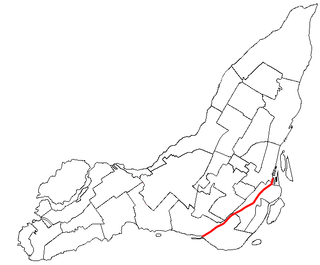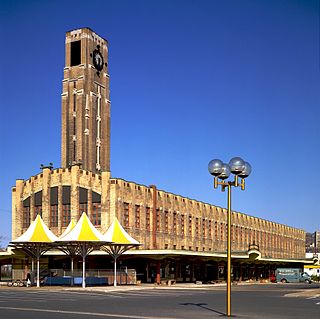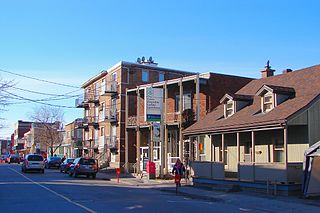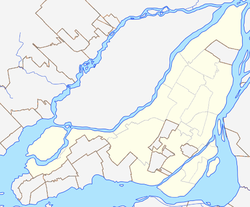
The Lachine Canal is a canal passing through the southwestern part of the Island of Montreal, Quebec, Canada, running 14.5 kilometres from the Old Port of Montreal to Lake Saint-Louis, through the boroughs of Lachine, Lasalle and Sud-Ouest.

Verdun is a borough (arrondissement) of the city of Montreal, Quebec, located in the southeastern part of the island.
Pointe-Saint-Charles is a neighbourhood in the borough of Le Sud-Ouest in the city of Montreal, Quebec, Canada. Historically a working-class area, the creation of many new housing units, the recycling of industrial buildings into business incubators, lofts, and condos, the 2002 re-opening of the canal as a recreation and tourism area, the improvement of public spaces, and heritage enhancement have all helped transform the neighbourhood and attract new residents. Community groups continue to be pro-active in areas related to the fight against poverty and the improvement of living conditions.

Le Sud-Ouest is a borough (arrondissement) of the city of Montreal, Quebec, Canada.

Saint-Henri is a neighbourhood in southwestern Montreal, Quebec, Canada, in the borough of Le Sud-Ouest.

Saint Jacques Street, or St. James Street, is a major street in Montreal, Quebec, Canada, running from Old Montreal westward to Lachine.
Ville-Émard is a neighbourhood located in the Sud-Ouest borough of Montreal, Quebec, Canada.

Atwater Market is a market hall located in the Saint-Henri area of Montreal, Quebec, Canada. It opened in 1933. The interior market is home to many butchers and the Première Moisson bakery and restaurant. The outside market has many farmers' stalls, which sell both local and imported produce, as well as two cheese stores, a wine store and a fish store.
The Montreal Public Libraries Network is the public library system on the Island of Montreal in Quebec, Canada. It is the largest French language public library system in North America, and also has items in English and other languages. Its central branch closed in March 2005 and its collections incorporated into the collections of the Grande Bibliothèque.

Ville Saint-Pierre is a small neighbourhood of the city of Montreal, Quebec, Canada, located in the Borough of Lachine. It was a separate town until it merged with Lachine in 1999. In 2002, the amalgamated city of Lachine merged into Montreal.

Atwater Avenue is a major north–south street located in Montreal, Quebec, Canada. It links Doctor Penfield Avenue in the Ville-Marie borough to the north, and Henri Duhamel Street in the Verdun borough to the south. It is named for Edwin Atwater. The street runs through the Atwater Tunnel near the Atwater Market in Saint-Henri, before climbing and straddling the border of the city of Westmount.

Notre-Dame Street is a historic east–west street located in Montreal, Quebec, Canada. It runs parallel to the Saint Lawrence River, from Lachine to the eastern tip of the island in Pointe-aux-Trembles, then continuing off the island into the Lanaudière region.

Saint Antoine Street, formerly known as Craig Street, is a street located in Montreal, Quebec, Canada. It runs to the south of Downtown Montreal and north of Old Montreal and Griffintown and Saint-Henri. It crosses the Quartier international de Montréal. Between Atwater Avenue and Greene Avenue, the north side of the street is in Westmount.
The Canal de l'Aqueduc is an open-air aqueduct canal on the Island of Montreal in Quebec, Canada, serving part of the drinking water needs of the city of Montreal.

Greene Avenue is a north-south street in Westmount and Montreal, Quebec, Canada. It links Sherbrooke Street West in the north and Saint-Ambroise Street West, near the Atwater Market and Lachine Canal in the south. North of Sherbrooke, it is known as Mount Pleasant Avenue.

Côte-Saint-Paul is a neighbourhood located in the Southwest Borough of Montreal, Quebec, Canada.

The Saint-Jacques Escarpment is a green space along an escarpment in the city of Montreal, west of downtown Montreal and adjacent to the neighbourhood of Notre-Dame-de-Grâce. The wooded area stretches 3 km (2 mi) long, covering over 20 ha.

Hospice Sainte-Cunégonde was an orphanage, child care centre and nursing home for the destitute in Montreal's Sainte-Cunégonde neighbourhood, today known as Little Burgundy. It was operated by the Grey Nuns, a Roman Catholic religious order based in Montreal. The hospice was established in 1889 in the former Brewster mansion, and moved in 1896 to its own building at 2625 Albert Street at the corner of Atwater Avenue. Albert Street is today named Lionel-Groulx Avenue. The building had a stone facade but its interior structure was built of timber.

Saint Patrick Street is a street in Montreal, Quebec, Canada.



















